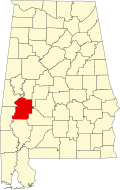Dayton, Alabama | |
|---|---|
 The Boddie law office, now the Dayton Town Hall, completed in 1858 | |
 Location in Marengo County, Alabama | |
| Coordinates: 32°20′59″N87°38′28″W / 32.34972°N 87.64111°W | |
| Country | United States |
| State | Alabama |
| County | Marengo |
| Incorporated | January 13, 1844 [1] |
| Area | |
• Total | 1.00 sq mi (2.59 km2) |
| • Land | 1.00 sq mi (2.59 km2) |
| • Water | 0 sq mi (0.00 km2) |
| Elevation | 243 ft (74 m) |
| Population | |
• Total | 28 |
| 27 | |
| • Density | 27.0/sq mi (10.44/km2) |
| Time zone | UTC−6 (Central (CST)) |
| • Summer (DST) | UTC−5 (CDT) |
| ZIP Code | 36738 |
| Area code | 334 |
| FIPS code | 01-19912 |
| GNIS feature ID | 0117151 [3] |
Dayton is a town in Marengo County, Alabama, United States. The population was 28 at the 2020 census. [4]

